Rad Tech Exam 2
1/146
There's no tags or description
Looks like no tags are added yet.
Name | Mastery | Learn | Test | Matching | Spaced |
|---|
No study sessions yet.
147 Terms
Affective
Behaviors, feelings, emotions, interests, attitudes, values, beliefs.
Cognitive
Knowledge, understanding, reason & judgement.
Psychomotor
Physical actions, neuromuscular manipulations and coordination.
Transfer of Learning
Learning in one context and applying that knowledge to another.
Didactic
informational and instructional activities that may occur in formal or informal settings, typically in the classroom, laboratory, or online
Learning Outcomes
program level measurable expectations for student learning
Purpose of clinical edcation
variety of clinical settings, competency based clinical education
Competency based clinical education
curriculum ASRT
Professional practice Standards ASRT
Competency Requirements ARRT
Education in Radiologic Sciences
education as a medical imaging professional that includes three areas of learning : cognitive, affective, and psychomotor
the ____ setting allows students integrate the knowledge gained from the _____ into clinical practice, working with patients
clinical, classroom
Didactic Instruction
–Occurs in formal settings, classroom, or online
–Provides students with the conceptual information
–Beginning phase of program

Laboratory Setting
–A bridge to connect didactic and clinic.
– Provides an opportunity for students to gain hands on skills

Clinical Experiences
–Enables students to transfer the learning from didactic and lab to real life situations with patients
–Learning continues in the clinical environment.
–Critical thinking develops in the clinical environment
–Permits one-on-one, direct patient contact

Performance objectives
–A description of an observable student behavior

Learning observed by way of competecies
–The observable, successful achievement of the performance objectives

learning outcomes
–Learner focused and identifies what the student should be able to achieve

Organization of Radiography programs
program director
clinical coordinator
clinical faculty instructor
clinical instructor
clinical staff
program director
–Organizes, administers and assesses the RADT program
–Responsible for both didactic and clinical effectiveness of program

clinical coordinator
Works closely with the PD, ensures program effectiveness, coordinates clinical facilities

clinical faculty instructor
–Schedules, coordinates and supervises each clinical course. Rotates through all clinical sites.

clinical instructor
–Works directly with the student assigned to the clinical setting.
–Must be competent in clinical instruction

clinical staff
–Employees at the clinical setting and provide student supervision and guidance

competencies are in three classification
–Mandatory (37)
–General Patient Care Competencies (10)
–Elective (15)

clinical competence must be performed
independently, consistently, and effectively.

demonstration of competence must include
•patient identity verification
•examination order verification;
•patient assessment;
•room preparation;
•patient management;
•equipment operation;
•technique selection;
•patient positioning;
•radiation safety;
•imaging processing; and
•image evaluation.
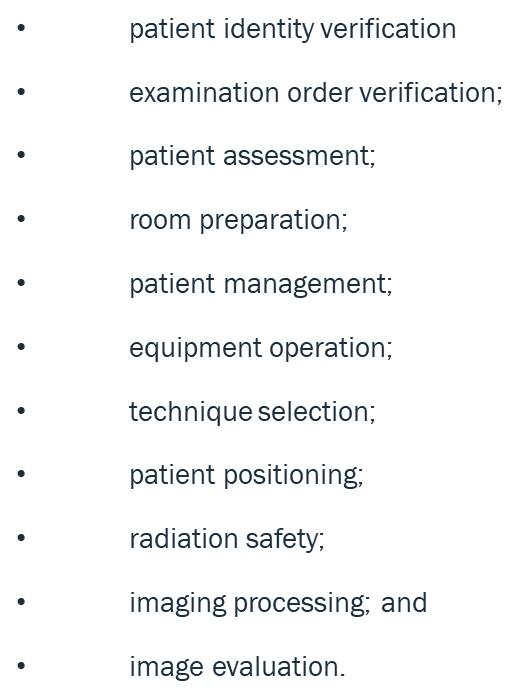
direct supervision
–Radiographer reviews exam request
–Evaluates the condition of the patient
–Be PHYSICALLY present during the procedure
–Review and approve the procedure and image
–
***All repeat procedures fall under direct supervision
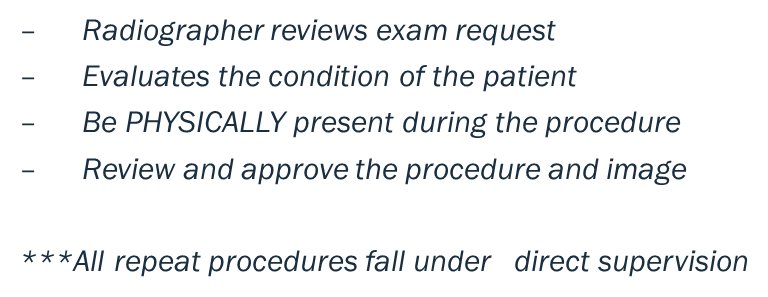
indirect supervision
–Radiographer reviews, evaluates and approves the procedure
–Only needs to be “immediately available” to assist student
–“immediately available” is the radiographer in the adjacent room or location

student clinical development
■Competency based
■Designed in three phases
■Allows for the translation of theory into practice in a real-world setting
■Designed in accordance with the Standards for an Accredited Educational Program in Radiography
–JRCERT

affective
one of the three major categories or domains of learning: includes behaviors guided by feelings and emotions that are influenced by an individuals interest, attitudes, values and beliefs
assist
activities in clinical that aid or support the performance of radiographic procedures and therapeutic treatments
clinical
procedures and activities that occur in outpatient and inpatient healthcare settings
clinical coordinator
program official responsible for coordinating clinical education and evaluation of its effectiveness
clinical instructor
program official responsible for clinical instruction, supervision and evaluation of students in the clinical setting
clinical staff
healthcare professionals employed in the clinical setting where students participate in clinical education and provide clinical supervision and guidance
cognitive
one of the three major categories or domains of learning; includes various levels of thought, such as knowledge, understanding, reason, and judgement
Comptency
observable and document successful achievement of performance objectives
didactic
informational and instructional activities that may occur in formal or informal settings, typically, in the classroom, laboratory, or online
direct supervision
oversight of clinical procedures or treatment by a qualified professional present in the exam or treatment room with the student
indirect supervision
oversight of clinical procedures by a qualified professional immediately available to the student
interprofessional education IPE
an approach to teaching students and healthcare workers where students or members of two or more professions learn with, from, and about each other to improve collaboration and the quality of patient care
learning outcomes
program level measurable expectations for student learning
objectives
topical concise descriptions of an observable behavior to be achieved by students as a result of their educational experiences within a course or educational module
observe
activities in clinical where students watch and listen to the performance of radiographic procedures and therapeutic treatments
program director
program official that provides leadership or the program and ensures program effectiviness
perform
activities in clinical where students complete radiographic procedures and therapeutic treatments with appropriate supervision of a qualified professional
psychomotor
one of the three major categories or domains of learning; includes behaviors involving physical actions, neuromuscular manipulation and coordination
SBAR (situation-background-assessment-recommendation)
a communication method used to assure effective handoff of patients from one healthcare worker to another
TeamSTEPPS ( team strategies and tools to enhance performance and patient safety)
An evidence based teamwork system that is used in many healthcare institutions to improve that quality, safety, and efficiency of healthcare
Transfer of learning
learning in one context and applying it to another
Adverse Drug Events (ADEs)
Injuries, large or small, caused by the use (including nonuse) of a drug; can be as harmless as a drug rash or as serious as death from an overdose; the two types of ADEs are those caused by errors and those that occur despite proper use
American College of Radiology
(ACR)
A professional medical society that has accredited more than 39,000 facilities in 10 imaging modalities to assist organizations in meeting governmental and third-party payer criteria; provides practice guidelines to improve patient safety practices in radiology services
American Healthcare Radiology
Administrators (AHRA)
A professional organization representing medical imaging management at all levels; manages the certified radiology administrator (CRA) credentialing process
Board of Directors or Governing
Board
Group of people authorized by law to conduct, maintain, and operate a hospital for the benefit of the public and whose legal and moral responsibility for policies and operations of the hospital are not for personal benefit of the members
Centers for Medicare & Medicaid Services (CMS)
Federal agency that administers the Medicare program and partners with states to administer Medicaid
Certificate of Need (CON)
Certificate approved by a local (state) review board permitting hospitals to construct new or additional facilities, open new services, or make large purchases—a condition required for reimbursement by Medicare
Certified Radiology Administrator
(CRA)
Professional who has demonstrated skill and knowledge in asset management, financial management, operations management, human resource management, and communication and information management in radiology
Chief Executive Officer (CEO)
Person appointed by the board of directors who has full accountability for the entire hospital or healthcare organization
Clinical Support Services
Services providing the components of patient care that collectively support the physician's plan for diagnoses and treatments
Continuous Quality Improvement
(CQI)
System of development in the workplace for daily improving performance at every level in every operational process by focusing on meeting or exceeding customer expectations
Department
Unit of the hospital with specific functions or specialized skills such as housekeeping, surgery, radiology, or accounting
Department Chair
Physician who represents a department or service and sits as a formal member of the executive medical staff committee; responsible for all of the medical operations of a hospital department and may also oversee a residency training program
Human Resources
Department
Ancillary department of the hospital responsible for recruiting, selecting, supporting, and compensating employees; developing and maintaining skills, quality, and motivation; collective bargaining; and occupational health and safety
The Joint Commission
(TJC)
Independent not-for-profit organization that evaluates and accredits more than 22,000 healthcare organizations and programs in the United States and is the nation's primary standard-setting and accrediting body in healthcare;
TJC standards focus on improving the quality and safety of patient care provided by healthcare organizations
Mammography Quality Standards Act and Program (MQSA)
Establishes
mammography program to ensure that all women have access to quality services; regulations developed by the US Food & Drug Administration (FDA) and the National
Mammography Quality Assurance
Advisory Committee
Medical Director Physician
responsible for the medical operation and quality of a hospital department or service; also responsible for providing input regarding policies and procedures and day-to-day operations of the department
Medical Error
Failure to complete a planned action as intended or the use of a wrong plan to achieve an aim; can be related to an incorrect diagnosis, equipment failure, infection, or a misinterpretation of an order
Medical Staff
Formal organization of physicians authorized to admit and attend to patients within a hospital; have authorized privileges, bylaws, elected officers, and various committees and activities (see Medical Director, Department Chair, and Service Chief)
Mission Statement
Statement of an organization that summarizes its intent to provide service in terms of the services it offers, the intended recipients of services, and a description of the level of cost
Occupational Safety and Health Administration (OSHA)
Federal agency that enforces standards for safety in the workplace, conducts inspections, and directs determination of fines for noncompliance with policies and regulations
Performance Improvement
(PI)
Process of identifying and analyzing important organizational and individual performance gaps, planning for future performance improvement, designing and developing cost-effective and ethically justifiable interventions to close performance gaps, implementing the interventions, and evaluating the financial and nonfinancial results
Radiology (Medical Imaging)
Department
Organization of a hospital or medical clinic that provides diagnostic imaging through medical technologies such as x-ray examination, fluoroscopy, computed tomography, interventional radiography, magnetic resonance imaging, mammography, nuclear medicine, and ultrasonography
Service Chief
Physician responsible for overseeing a component or subdepartment of a hospital service-for example, a radiologist who is chief of the nuclear medicine service
Third-Party Payers
Insurance companies, Medicare, Medicaid, and other commercial companies that are the payers of inpatient and outpatient medical expenses for the patient
Total Quality Management
(TQM)
Management of quality in the workplace from a perspective of total involvement of every employee, with a strong focus on process measurement and control
three phases of clinical learning
observation, assistance, performance
observation
–Initial stage of clinical education
–As clinical situations are new to student
–After gaining knowledge in didactic and laboratory setting
–Watch and learn

assistance
–Student Aids and supports technologist
–Hands on experience
–Interacts and positions patient and equipment

performance
–Performs entire procedure independently and under appropriate Supervision

clinical assesement
Student’s ability to perform in the clinical setting is assessed during each clinical rotation.
Student receives feedback and constructive criticism from both faculty clinical instructor and clinical instructors at the clinical site

student asses on _____ during clinical assessment
■Assessing the request
■Preparing room for exam
■Caring for the needs of patient
■Communicating with the patient
■Performing the procedure
■Providing radiation protection
■Manipulating exposure factors
■Evaluating the radiographic image
■Manipulating specializing equipment
■Appropriate discharging the patient

student’s ____ behavior is also assessed during each clinical rotation
affective:
■Ability to communicate effectively with staff and patients
■Perceive patient needs
■Display maturity and confidence
■Follow through with clinical responsibilies

major clincal education policies
■Professional Ethics
■Practice Standards
■Radiation safety
■Pregnancy
■Attendance and Tardiness
■Professional Appearance and behavior
■Drug and Alcohol
■Infection Control
■Nondiscrimination
■Social Media
■HIPAA/Pt Confidentiality
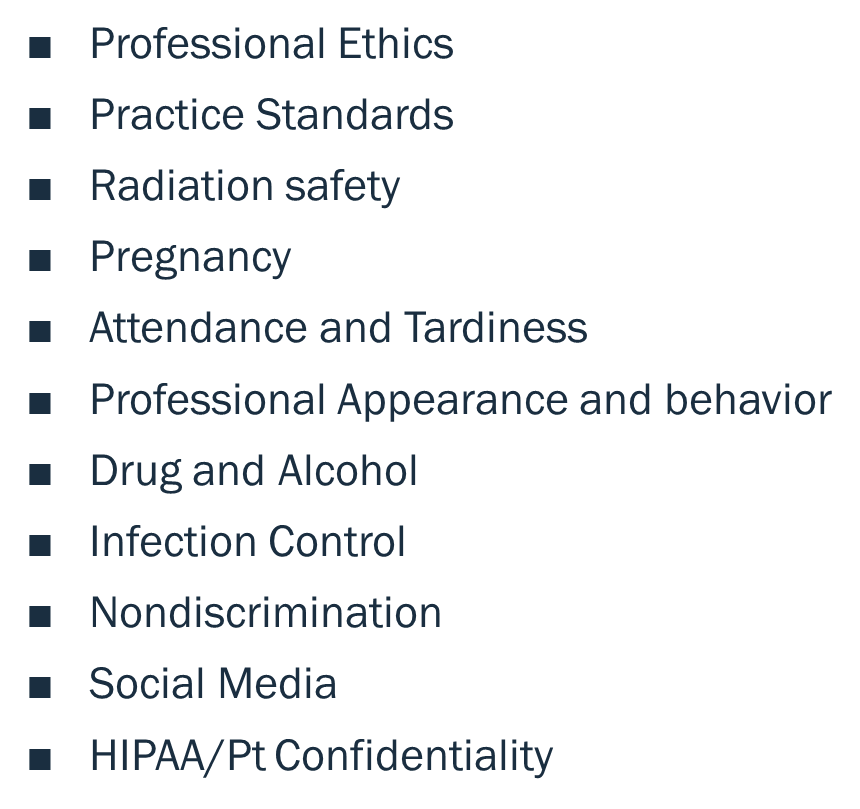
TeamSTEPPS
■Team Strategies and Tools to Enhance Performance and Patient Safety
■Evidence based teamwork system used in health care institutions to improve the quality, safety, and efficiency of healhcare.
■Creates highly effective teams to assure best patient outcomes.

5 key principles of TeamSTEPPS
–Team structure
–Communication
–Leadership
–Situation Monitoring
–Mutual Support
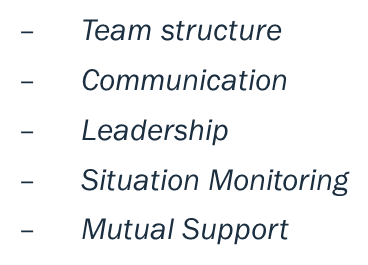
SBAR
situation, background, assessmet, and recommendation
•Communication method used to assure an effective handoff of patients from one health care worker to another.

Hospitals
Have a direct relationship to the community in which they are located. The relationship should be supportive and beneficial for both parties

hospital environment
Hospitals are like “communities within communities.”
Hospitals serve a community need.
Hospitals are staffed by various types of workers.

hospital mission
The hospital Mission Statement defines the purpose of the hospital’s existence and provides guidance in its community service.
All hospital staff are committed to accomplishment of the Mission.
Hospital directives and projects support the Mission.

organizational structure
Governance of a hospital begins with the board of directors or governing board.
The President or Chief Executive Officer (CEO) is accountable to the hospital board.
The hospital divisions and departments are accountable to the CEO.

medical imaging
Plays a critically important role in hospital operations and success
Works closely with other departments to provide patient care and revenue for the hospital

health care trends and hospitals
Hospitals are more horizontal in organizational structure.
Reimbursement shifts from inpatients to outpatients.
Strong emphasis on use of services
Declining reimbursements from government programs
Focus for reimbursement will shift to patient experience quality measures.


Newer organizational designs reflect

the interrelationship among medical departments with common patient care experiences.
radiology organization
Varies depending on size and scope
Often consists of subdepartments
Requires support services
Led by Administrative Director
administrative director of radiology
Typically reports directly to upper hospital administration
Requires strong business management skills
Not necessarily a radiologic technologist
Works closely with Medical Director of Radiology

medical director
Typically a physician
Principle responsibility is for overseeing the quality of patient care
Works closely with Administrative Director
May also serve as Department Chair

role of the radiographer
Perform radiographic examinations
Perform patient care and assessment
Adhere to radiation protection guidelines
Follow practice standards
Assist the Radiologist
responsibilities of the health care facility
Care for all patients regardless of their condition
Promote health
Prevent illness
Education
Research

changing health care trends have created non-tradiontal health care settings like:
Clinics
Outpatient Imaging Centers
Freestanding Imaging Centers
Mobile Imaging Services
Outpatient Surgery Centers
Urgent Care Centers
clinics
Typically have physicians and a range of imaging modalities and laboratory services

physician offices
Similar to a clinic and usually serve as a home base for a physician’s practice. They may offer imaging in their office
